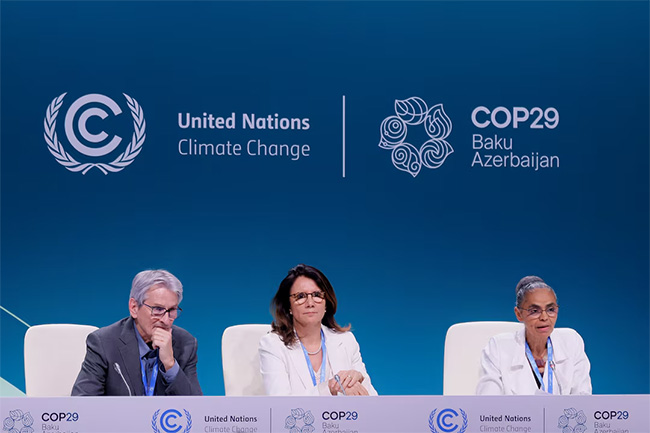COP29, which started on the 11th and ended on the 22nd of November 2024, has observed melting of two weeks with little more than expected. While participants were packing, anxiety, discontent, and frustrations were still holding most of them with endless questions.
The ambitious results expected, particularly in Finance, which was thought to have been a disappointment, at least for the Developing Countries.
COP29, dubbed the Finance COP, turned out to be dramatic, with critics accusing it of being a platform for sharing sympathetic stories with little action.
The highly needed finance was pledged yet was below the real reasonable amount, given the massive destruction that needs repairs. However, there were some positive aspects worth highlighting.
Setting standards for Carbon markets was one major achievement reached quite early during this meeting. Under Article 6 of the Paris Agreement, the setting of a system for international carbon credits projects was agreed upon.
This will now witness the upscaling of the carbon credits project, which, as estimated, would save more than 250 billion dollars annually from climate action costs.
RELATED: COP29: Will Africa’s Climate Desires Finally Be Fulfilled at Finance COP?
There were two standards agreed upon immediately under Article 6.4.
i) The methodology requirement for developing and assessing eligible carbon credits for a UN carbon-marked Paris Agreement Credit Mechanism.
ii) Requirements for projects to remove greenhouse gases from the atmosphere—how they should be monitored and approaches. These were yet to be further improved, but they were at least approved pending Supervisory Boy’s elaboration.
Funding for climate action received a gentle push although was not so satisfying. According to a report published by the UN’s Independent High-Level Expert Group on Climate Finance at the conference, global projected investment needed for climate action is around US$6.3–6.7 trillion per year by 2030.
The CO29 aimed to set a new collective goal for climate finance, going beyond the previous $100 billion annual commitment, which was only recently met.
However, this has not been realised; the finances were just gently adjusted, which became a frustrating moment for the Developing Countries.
Besides that, blended fiancé initiatives gained momentum after the Singapore government announced about 500 million dollars to support the Financing Asias Transition Partnership (FAST-P).
This Asia pe ser decarbonization projects was at least an additional and indicator of multilateralism and regional initiative which is blended approach with BlackRock, MAS, IFC, MUFG, NEXI, and AIA showed specific intention and signed arrangement.
Strengthening Nationally Determined Contributions (NDCs) whereby Countries are need to submit their updated NDCs under the Paris Agreement by February next year ahead of COP30 in Brazil.
Several over countries have already indicated their updated NDCs and more to follow suit which is a good gesture for the upcoming Brazil COP30 where they will have to submit their NDCs.
The African Group of Negotiators on Climate Change (AGN), currently chaired by the Republic of Kenya through Amb Ali Mohamed, initially released a document emphasizing the possibility of repeating past mistakes.
The statement illiterates that ‘’inadequate implementation of the $100 billion annual goal, would undermine the delivery of the Paris Agreement’s aims’’.
In that sense, they indicated the commitments of the African countries and developing countries to engage in constructive debate while upholding the principles of equity and fairness from all parties.
Even though the Baku departure did not bring the longed-for hopes rather than dismay and frustrations, the proposed amount of $300 billion, which was sealed at the end of the Baku COP29, falls far short of the estimated $5.1–6.8 trillion needed for climate action by 2030.
The COP29 faced several delays and disagreements, particularly around the new global goal on climate finance. These issues caused the conference to be extended beyond its planned schedule.
The initial schedule was meant to be on 21st but with an extra one day the deal was reached although under very strained way.
It was indeed intense and challenging to reach the deal, which still needs much work to meet the anticipated global climate goals.
Nevertheless, COP29 has brought another step forward towards the right path even under the current disappointing moment, which came out of expectations, particularly from developing countries.
It has paved the way for the upcoming COP30, which will take place in Brazil. It has also brought in many delegations with the hope that they will learn from current criticisms, which will shape their roles as the next president.
Mixed reactions were noted, with frustrations and disappointments obvious for Developing Countries, including the small island states.
However, another group of countries, including some from Africa, such as South Africa, explained their satisfaction with the conference’s results.
So, the majority opinionated that the conference still holds the value it is supposed to hold; the challenge remained in meeting diverse expectations.
The COPs always feature a series of fading hopes and the reappearance of new hopes, which will be reflected in upcoming Conferences. This is a reminder that the journey towards comprehensive climate action is complex and often filled with differing perspectives and expectations.

